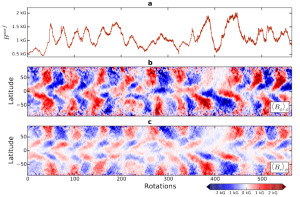New paper on magnetic cycle simulation of Proxima Centauri

Time evolution of the area-averaged surface magnetic field strength, the longitudinally-averaged longitudinal magnetic field, and the longitudinally-averaged radial magnetic field in a simulation of a Proxima-Centauri-like M dwarf.
The recent discovery of an Earth-like exoplanet around Proxima Centauri has shined a spot light on slowly rotating fully convective M-stars. When such stars rotate rapidly (period <20 days), they are known to generate very high levels of activity that is powered by a magnetic field much stronger than the solar magnetic field. Recent theoretical efforts are beginning to understand the dynamo process that generates such strong magnetic fields. However, the observational and theoretical landscape remains relatively uncharted for fully convective M-stars that rotate slowly. Here we present an anelastic dynamo simulation for Proxima Centauri, a representative case for slowly rotating fully connective M-stars. The rotating convection spontaneously generates strong differential rotation in the convection zone which drives coherent magnetic cycles where the axisymmetric magnetic field repeatedly changes polarity at all latitudes as time progress. The typical length of the `activity’ cycle in the simulation is about nine years, in good agreement with the recently proposed activity cycle length of about seven years for Proxima Centauri. Comparing our results with earlier work, we hypothesis that the dynamo mechanism undergoes a fundamental change in nature as fully convective stars spin down with age.
“Magnetic cycles in a dynamo simulation of fully convective M-star Proxima Centauri”, The Astrophysical Journal Letters, Volume 833, Issue 2, article id. L28, 6 pp. (2016); Yadav, Rakesh K.; Christensen, Ulrich R.; Wolk, Scott J.; Poppenhaeger, Katja.